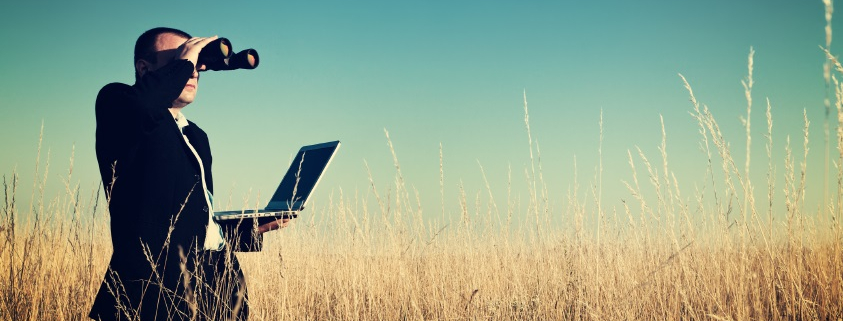Using scenario planning to see the world past COVID-19: a compilation of 5 insightful sets of scenarios
Scenario planning, the discipline of building multiple relevant stories of the future to support effective decision-making, always a powerful tool for foresight, is even more relevant as uncertainty increases, making it an extremely important and valuable tool amidst our current pandemic.
I have been applying scenario planning for well over 20 years, sometimes in its traditional format, sometimes with adaptations to fit the need or cultural context of the client.
The more specific the context framing a set of scenarios, in terms of geography, industry, organization, and defined decision, the more useful they are.
However it can also be highly instructive and insightful to draw on more generic scenarios that help frame uncertainty and possible futures, helping to build scenario thinking and richer mental models.
I have compiled four sets of recently-developed scenarios that can help us see possible worlds past the current pandemic, that hopefully can inspire us to work towards those we see as compelling, and make us conspire to avoid those we don’t like.
Deloitte
The deeply experienced scenario team at Deloitte, drawing on their lineage from Global Business Network, have created an excellent nuanced set of scenarios in a detailed report.
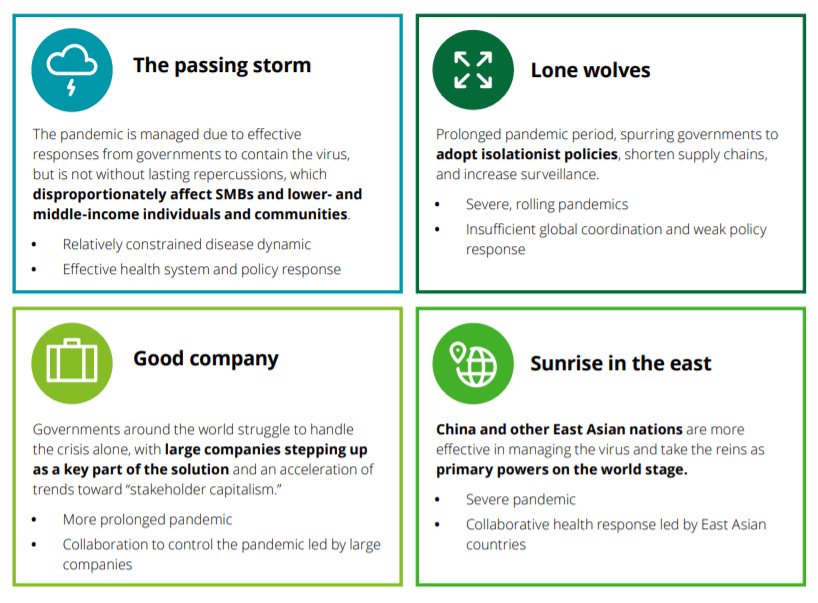
Source: Deloitte: The world remade by COVID-19
In addition to describing each of the scenarios, the report explores in detail the key uncertainties that will frame our path forward.
It suggests 5 fundamental uncertainties:
1. The overall severity of the pandemic and pattern of disease progression
2. The level of collaboration within and between countries
3. The health care system response to the crisis
4. The economic consequences of the crisis
5. The level of social cohesion in response to the crisis
From this broader list it distills the two critical uncertainties that will drive the overall impact of COVID-19 as the severity of the pandemic and the level of collaboration, allowing them to map the scenarios:
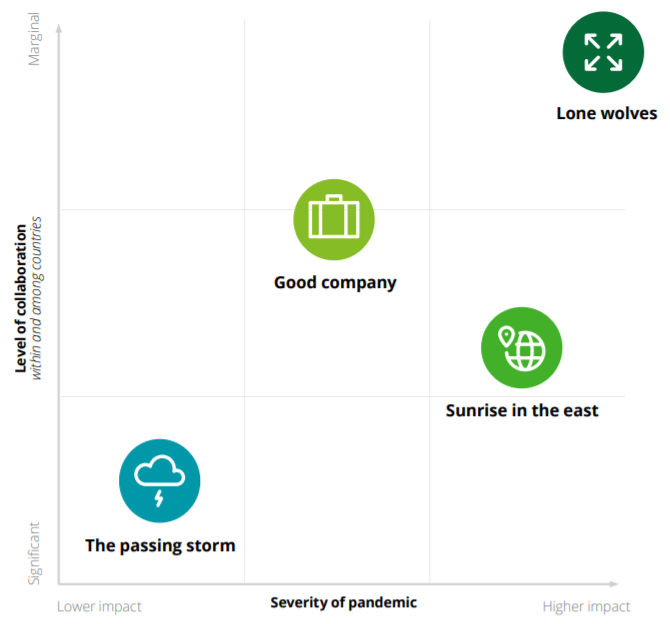
See the full report for deeper descriptions and insights.
Journal for Futures Studies
The academic Journal for Futures Studies contains a short article What will a post virus world look like? by Garry Honey that proposes a simple framework for a set of scenarios:
“The coronavirus throws up enormous uncertainty – political, economic, social and technical – so it seems the best way to look at future scenarios is to examine where each of these determinants might lead. The four scenarios set out below using the political-social and economic-technical axes.”
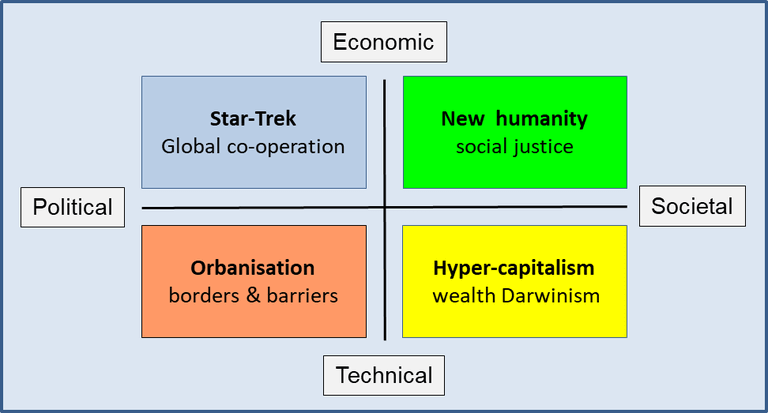
Interestingly the ‘New humanity’ scenario here echoes my ‘Humanity maturing’ scenario from a different exercise.
See the article for full scenario descriptions.
Centre for the Understanding of Sustainable Prosperity
As part of an extended and insightful essay by Simon Mair of the Centre for the Understanding of Sustainable Prosperity, he proposes a scenario matrix:
“The factors I want to take are value and centralisation. Value refers to whatever is the guiding principle of our economy. Do we use our resources to maximise exchanges and money, or do we use them to maximise life? Centralisation refers to the ways that things are organised, either by of lots of small units or by one big commanding force.”
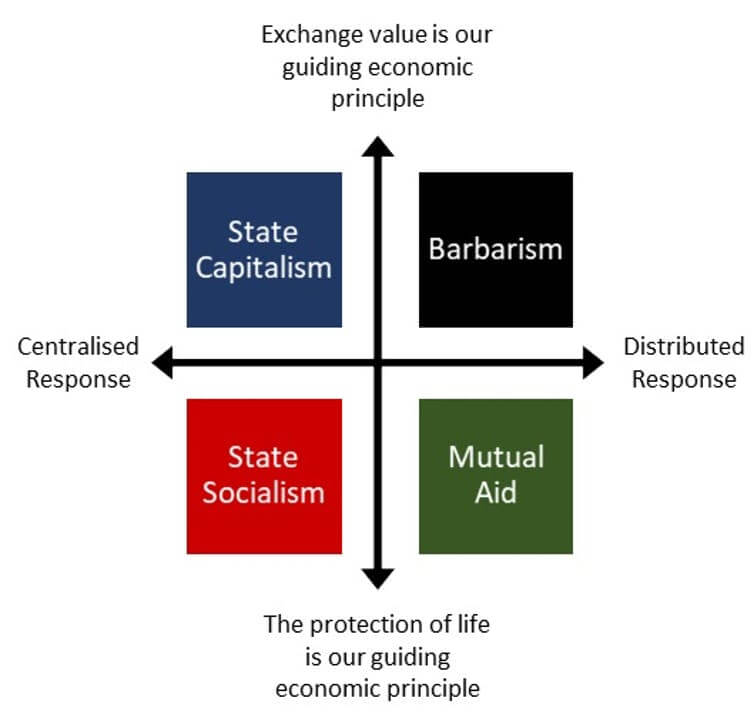
1) State capitalism: centralised response, prioritising exchange value
2) Barbarism: decentralised response prioritising exchange value
3) State socialism: centralised response, prioritising the protection of life
4) Mutual aid: decentralised response prioritising the protection of life.
See the full essay and scenario descriptions.
Center for Strategic & International Studies
Usually bad/ medium/ good scenarios are next to useless for true foresight, and anathema to experienced scenario planners. The richness and value of scenario planning comes from exploring multiple dimensions of uncertainty. However in a situation such as a pandemic, policy makers can certainly be well informed by considering realistic pathways from worse to better.
To take one of many examples of these kinds of scenarios for the trajectory of the pandemic, the Center for Strategic & International Studies proposes three scenarios:
Scenario 1: Best Case – Rapid Recovery
Scenario 2: Mixed Case – Roller Coaster
Scenario 3: Worst Case – Decline and Catastrophe
Which leads them to come to the very reasonable conclusion: “the time to act is now”
Clem Sunter
South African scenario planner Clem Sunter, famous for his seminal work in the 1980s framing a ‘High Road’ scenario for South Africa to emerge from apartheid, has suggested four scenarios for what life will be like as we lift Covid-19 lockdown.
In early March Sunter initially proposed three scenarios:
Much ado about nothing. “This scenario can almost certainly be discarded as a way of interpreting the past and the future of the pandemic”
The Camel’s Straw. “The coronavirus does not have to kill millions of people to be the straw that breaks the camel’s back.”
Spain again. “A repeat of the Spanish flu of the last century, which killed 3 to 5% of the world’s population, will remain in play until a vaccine is found”
He has more recently added a fourth scenario:
Tightrope. “A delicate balancing act between preserving lives and livelihoods”
See the article for the full scenario descriptions.
Learning from scenarios
If you examine each of these scenario sets, you will see common themes emerging, which given the diversity and expertise of those creating these scenarios, are likely to be the ones most prominent in understanding our potential path forward, especially collectively within nations and globally.
These kinds of scenarios, ideally created for a specific organization and the decision it faces, can certainly be invaluable for making effective strategic decisions in the face of intense uncertainty.
They can also be used as an inspiration.
At the beginning of this year, before coronavirus was on the radar for all but a few, I wrote that “the 2020s will be a pivotal decade: we all have a responsibility to believe it can be positive for humanity“.
This is just as true today, a few months later, in arguably more so.
As such, the single most valuable outcome of using scenarios is to bring us to understand and believe that better futures are possible, and identify the actions that are most likely to lead to that scenario.

